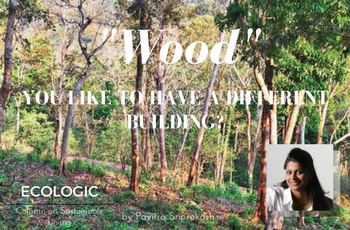‘Wood’ you like to have a different building?
Wood is among the top sustainable building materials in my country,” said Japanese architect Yasuki while commencing his lecture at a local architecture college. Students looked aghast at my friend since wooden buildings are non-existent in urban India. The reason for this soon became obvious: almost 100% of forests in our country are protected, but 80% of the forests in Japan are managed for commercial use, that
includes applications in the building industry.
Last year, the Ministry of Environment and Forests released the draft of India’s new National Forest Policy as an update to the 1988 policy. The stress is now on afforestation strategies, and growing trees outside forestlands to combat climate change. The national goal to keep a minimum of one-third of the geographical area under forests cover is still maintained. However the rule to maintain two-thirds of the geographical area under forest cover for hill and mountainous regions has been eased. Which then raises the question, will building with wood ever become ‘sustainable’ in India?
By definition, sustainable forest management (SFM) addresses the seamless production or a continuous flow of forest products and services without any undesirable effects on the physical and social environments. The Forest Stewardship Council (FSC) promotes responsible management of the world’s forests internationally. The Programme for the Endorsement of Forest Certification (PEFC) is another independent third-party certification programme for SFM.
Their stipulated best practices ensures that both timber and non-timber forest products maintain the highest ecological, social and ethical standards throughout the forest to finished products supply chain. Apart from setting such standards, the forest products are also certified and labeled as eco-friendly. Such eco-labels allow customers to easily identify products from sustainably managed forests.
Only in mid-2015 an indigenous forest certification programme was launched, whose biggest challenge continues to be the unsustainable use of forest wood as fuel. Our building industry doesn’t even figure in the list of Indian wood users. because of this rule, logs account for 67% of all wood imported into India as the local preference is for unprocessed wood.
South East Asia and African countries meet India’s demand and the carbon footprint of these logs is huge, which makes wood even more of an unsustainable building material.
The popular LEED green rating system requires that 50% of wood-based materials and products (based on cost) are FSC certified. Typical building components that are considered include structural framing, flooring, sub-flooring, wooden doors and finishes. Consumption of Indian made materials have by and large increased, but stringent green rating conditions in buildings dissuades use of wood products. The amount of certified wood needed to attain a LEED point remains significant, and the building industry perforce imports to meet demand.
Till India develops a SFM certification standard the compelling import option will impair adoption of wood as a common material of building construction. Local wood is not sustainably produced or harvested and certified wood has a larger ecological footprint! If you think wood is a wonderful material, then support forestry and nurture more trees. After all, two thirds of Japan’s land area is forest!



